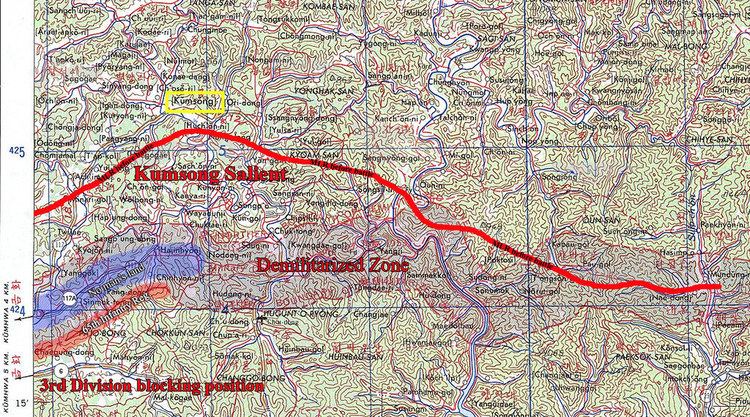Dates 13 Jul 1953 – 27 Jul 1953 Location Korea | Result Chinese victory | |
 | ||
187,000 combat troopsnumerous combat aircraft 240,000 combat troops1,360 artillery pieces South Korean sources 2,689 killed7,548 wounded4,136 missingChinese estimation 78,000 Chinese sources 32,253South Korean estimation 66,000 Similar Korean War, Battle of Bloody Ridge, Battle of Taejon, Battle of Osan, Battle of Pyongtaek | ||
Battle of kumsong
The Battle of the Kumsong River, also known as the Jincheng Campaign (Chinese: 金城战役; pinyin: Jīn Chéng Zhàn Yì), was one of the last battles of the Korean War as well as the last large-scale battle of the war. In July 1953, after the Republic of Korea (ROK) refused to participate in peace negotiations between the Communist and UN forces, the Chinese forces launched an attack on the Kumsong River Salient at the south of the town of Kumsong, scoring a victory over the UNC forces.
Contents
Battle of kumsong
Prelude
During the ceasefire negotiations seeking to end the Korean War, the UN and Communist forces were unable to agree on the issue of prisoner repatriation. ROK President Syngman Rhee, who refused to sign the armistice, released 27,000 North Korean prisoners. This action caused an outrage among Chinese and North Korean commands and threatened to derail the ongoing negotiations. As a result, the Chinese decided to launch an offensive aimed at the Kumsong River Salient, which was held by the ROK II Corps. This would be the last large-scale offensive the Chinese would ever commence in the war.
Battle
The battle was the only engagement of the war in which the Chinese forces had a clear superiority in firepower. After concentrating overwhelming strength in the Kumsong sector, the Chinese forces launched an offensive along a 22-kilometer front which broke the UNC defenses in the Kumsong River salient located north of the river. Responding to these developments, General Maxwell D. Taylor issued an order on July 14 for the US 3rd Infantry Division and ROK II Corps to retreat to the southern bank of the river, but the latter retreated in disarray after they lost contact and control with their respective units. Later the same day, however, the salient was completely destroyed, along with the elite "White Tiger" regiment of the ROK Capital Division, and thousands of American and South Korean soldiers were taken prisoner. Chinese advances permitting them to control an area of 192.6 square kilometers. After penetrating 30 miles (19 km) southward to the banks of the river itself, they then consolidated their positions in the river's southern bank, thus creating a gap in the lines of the 8th Army.
On July 16, the ROK II Corps consisting of 4th, 5th, 6th, 7th, 8th, and 11th Divisions, supported by UNC air power and artillery, counter-attacked the Chinese forces but were unable to retake the area in the face of heavy losses they suffered, and by July 20, their counteroffensive have died down. However, fighting in the area did not stop until July 27 that same year when the Korean Armistice Agreement was signed, thus ending the battle and the war.
